Homage to “The World’s Greenest Commercial Building” – Pt 1 of 2

The focus of this blog must return to its origins, now and then.
Namely, how to design, build and operate very energy-efficient and environmentally sustainable buildings.
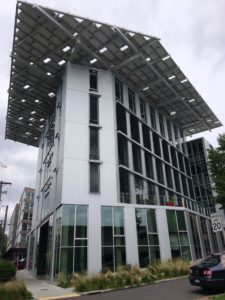 What’s the world’s most sustainable commercial building? That’d be the 50K sq. ft. 6-story Bullitt Center, located in Seattle, WA.
What’s the world’s most sustainable commercial building? That’d be the 50K sq. ft. 6-story Bullitt Center, located in Seattle, WA.
In a few words, it’s a “living building.”
I toured it back in June while on vacation in the PacNW. (I couldn’t have been more excited to learn of it first-hand, top-to-bottom … as I am to share it with you now.)
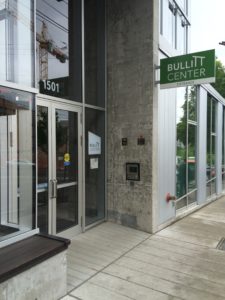 This building has achieved the most rigorous of voluntary sustainable building certifications. It’s Living Building Challenge (2.0) certified. Claimed lifespan for the building is 250 years. It’s also LEED® Platinum certified; that rating system’s highest.
This building has achieved the most rigorous of voluntary sustainable building certifications. It’s Living Building Challenge (2.0) certified. Claimed lifespan for the building is 250 years. It’s also LEED® Platinum certified; that rating system’s highest.
From the Bullitt Foundation’s website comes this thumbnail of the Living Building Challenge Imperatives (so-called) in place at the building as of the certification.
- Site: The location supports a pedestrian-, bicycle-, and transit-friendly lifestyle.
- Water: Rainwater is collected on the roof, stored in an underground cistern and used throughout the building (once approved by the regulatory authorities).
- Energy: A solar array generates as much electricity as the building uses (actually 60% more than we used in 2014).
- Health: The building promotes health for its occupants, with inviting stairways, operable windows and features to promote walking and resource sharing.
- Materials: The building does not contain “Red List” hazardous materials, including PVC, cadmium, lead, mercury and hormone-mimicking substances, all of which are commonly found in building components.
- Equity: All workstations are within 30 feet of large operable windows, offering workers access to fresh air and natural daylight.
- Beauty: Stunning architecture, an innovative photovoltaic [PV] array, a green roof and other native plantings, large structural timbers and a revitalized pocket park help beautify the surrounding neighborhood.
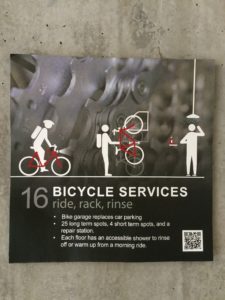 Site: The site is located on a hill with a fair slope. For bike commuters coming to the building, the uphill climb isn’t too bad. The downhill is long enough to be a brake-wearing experience.
Site: The site is located on a hill with a fair slope. For bike commuters coming to the building, the uphill climb isn’t too bad. The downhill is long enough to be a brake-wearing experience.
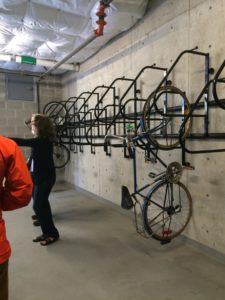 Note in the pix of the Bicycle Service info sign is an embedded bar code. I scanned it with my phone to investigate. The redirect sent me to the Bullitt Foundation web page containing more information about Bicycle Services.
Note in the pix of the Bicycle Service info sign is an embedded bar code. I scanned it with my phone to investigate. The redirect sent me to the Bullitt Foundation web page containing more information about Bicycle Services.
Many of the info signs throughout have bar codes for scanning with some of the explanations rather detailed, ergo extra informative of the particular green building feature.
While bicycle transportation is encouraged, there are, to be sure, surface parking lots (real estate nomenclature: “interim use”) within a block. But I’d bet a good share of the people who work in the Bullitt Center ride their bikes once or more often/wk.
That there’s a certification-required shower/changing room as a companion to bike commuting makes readying for work in case of a hot, humid or rainy ride doable.
Too, the other multi-modal transportation offerings within a short distance (1/2-mi.) of the building entryway are outstanding: streetcar, bus, light-rail plus numerous ZipCar/Car2Go locations.
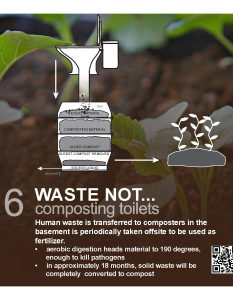
 Water: It’s been my experience when touring the most environmentally friendly buildings one is most likely to find, there’s an invariable fascination with composting toilets.
Water: It’s been my experience when touring the most environmentally friendly buildings one is most likely to find, there’s an invariable fascination with composting toilets.

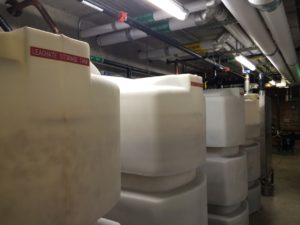 The on-site tanks pictured right hold the commode and urinal waste for managed aerobic decomposition and reuse. One person’s use of a waterless composting toilet can save as much as 18 gals of water/day. And, as much as 80#s of compost material/year can be harvested for soil regeneration where needed.
The on-site tanks pictured right hold the commode and urinal waste for managed aerobic decomposition and reuse. One person’s use of a waterless composting toilet can save as much as 18 gals of water/day. And, as much as 80#s of compost material/year can be harvested for soil regeneration where needed.
Twice I’ve toured the LEED® Platinum certified Merrill Center, the Annapolis, MD, HQ for the Chesapeake Bay Foundation. Looking a bit flushed or amused, women and men invariably want to check out their respective bathrooms to glimpse these on-site human waste recyclers.
Mostly I think they want to be assured that there’s no outhouse smell apparent. (For an excellent discussion about how it works at Bullitt Center, click here.)
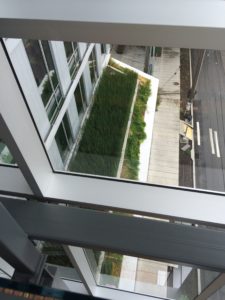
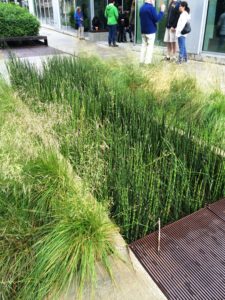 Another building feature is a rain garden, seen in the pix left that looks through the exterior windows to a small roof terrace just above the first floor bumpout. Rainwater harvested there becomes greywater for irrigating a “constructed wetlands” in the plaza just adjacent to the building’s entryway.
Another building feature is a rain garden, seen in the pix left that looks through the exterior windows to a small roof terrace just above the first floor bumpout. Rainwater harvested there becomes greywater for irrigating a “constructed wetlands” in the plaza just adjacent to the building’s entryway.
Also rated under the category Beauty, this wetland is “entirely of equisetum, commonly known as horsetail. These plants are extremely hardy and thrive well in Seattle, and are a natural choice for a wetland that is expected to work so hard.”
Before leaving Water, let me have you know about collected rainwater from the roof as described on the Foundation’s website:
“Below the solar panels, a parapet roof captures rainwater and brings it to downspouts that carry the water to a 56,000-gallon, concrete cistern in the basement. On its way down, the water is funneled through a vortex filter, which removes large particulates. Next to the cistern is a “day-use tank” that holds 500 gallons of clean, potable water.
“To create the potable water, the rainwater is ‘ultra-filtered’ through three ceramic filters, with the finest removing viruses. The rainwater is also passed under ultraviolet light and through activated charcoal and a small amount of chlorine is added. While chlorine is a toxic chemical, research showed examples of people getting sick from bacterial growth on faucet heads, so the team decided to use a small amount of chlorine – then remove it at the faucet head with activated charcoal – to protect public health.”
There’s much more to know about this laudable, landmark contribution to a highly sustainable built environment. I’ll do that in Part 2, to be published about this same time tomorrow.